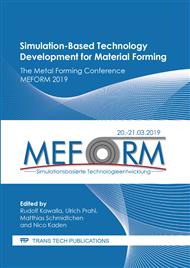p.1
p.7
p.15
p.24
p.32
p.40
p.48
p.57
Model Predictive Control of the Punch Speed for Damage Reduction in Isothermal Hot Forming
Abstract:
Isothermal forging processes are typically used for near-net shaping of high-performance components such as turbine discs and blades. Recent developments have introduced isothermally forged titanium aluminides into commercial jet engines. Titanium aluminides are lightweight intermetallic compounds with excellent creep properties but very limited ductility. Their low workability requires isothermal forging at slow strain rates, which is typically kept constant in the process. This work explores the possibility of controlling the strain rate during the process using model predictive control, so that the process time is reduced while the microstructure transformation and the amount of damage introduced into the workpiece are controlled. The results of isothermal compression with friction show that both an acceleration of the process and a reduction of damage are possible using the suggested control strategy.
Info:
Periodical:
Pages:
1-6
Citation:
Online since:
March 2019
Authors:
Keywords:
Permissions:
Share:
Citation:


